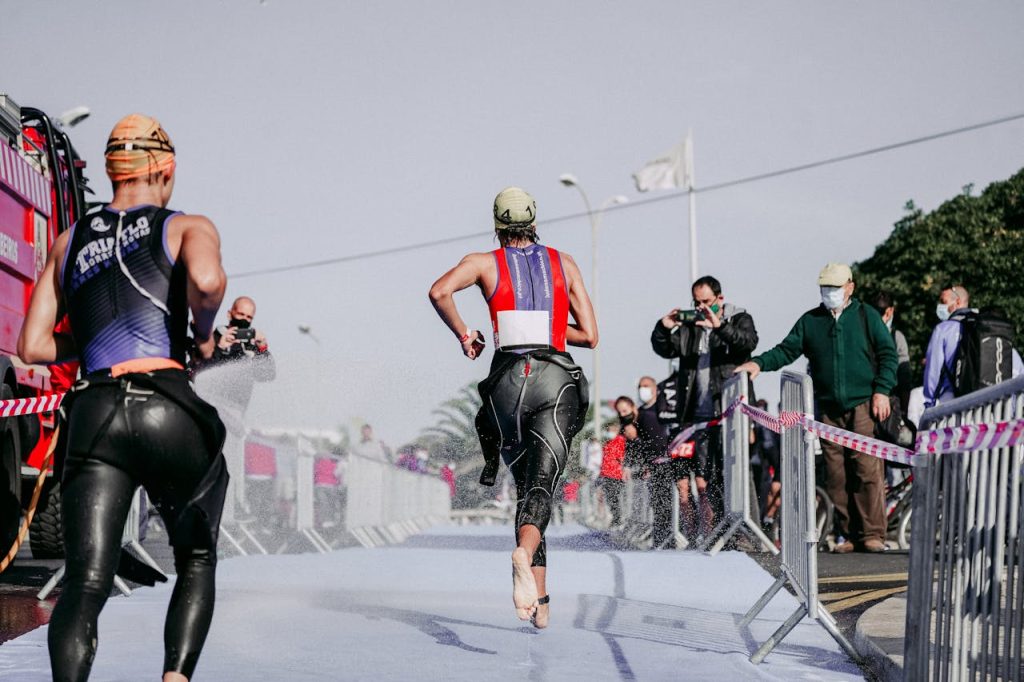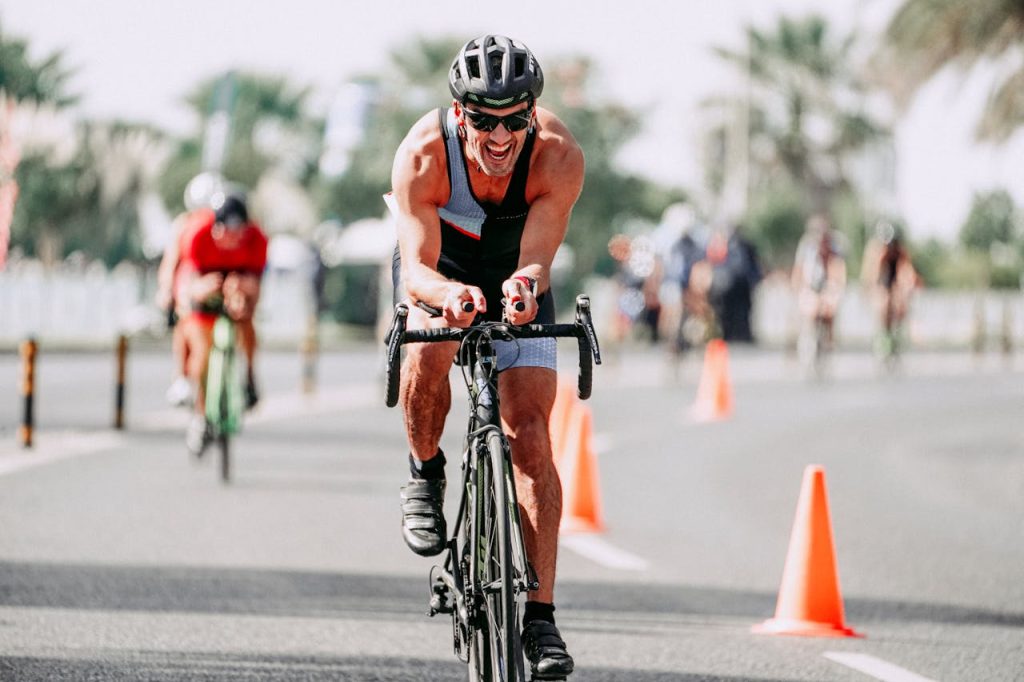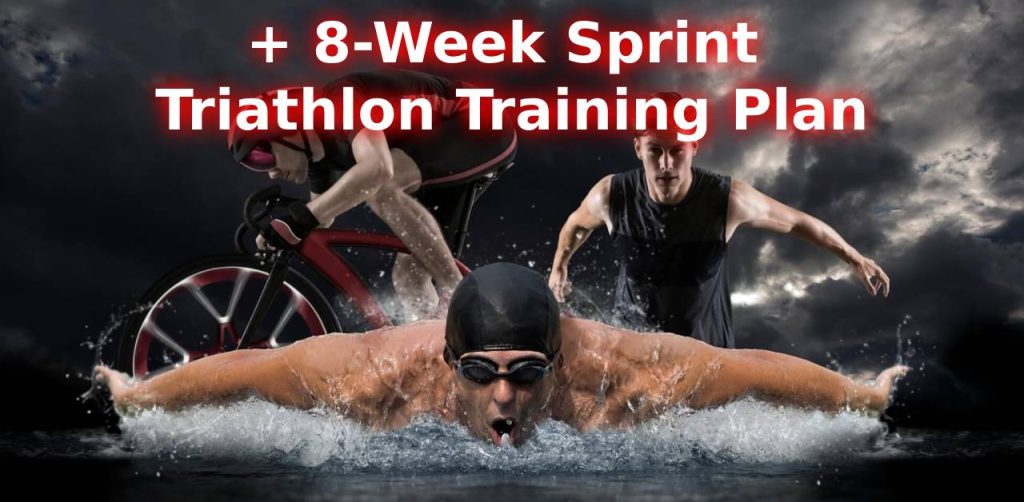Imagine the crowd cheering as you cross the finish line of your first sprint triathlon. That moment of triumph and exhilaration, soaked in sweat but beaming with accomplishment, is within your reach. What if I told you that all it takes to turn this dream into reality is the right triathlon training plan for beginners and a sprinkle of determination?
The world of triathlons offers an adventure that tests your limits and expands your horizons. It’s a thrilling blend of swimming, cycling, and running, pushing you to discover what you’re truly capable of.
For beginners, the idea of completing a sprint triathlon might seem like a distant goal. However, with a well-crafted triathlon training plan, that goal is not only achievable but also an exciting journey waiting to unfold. But how to train for a triathlon? and how do you ensure you’re on the right path? Let’s find out.
Table of contetns
MORE keyboard_double_arrow_down LESS keyboard_double_arrow_up
All You Need to Know About Triathlons
Triathlon training is like a three-part harmony, each discipline contributing to the melody of your race day performance. Balancing the act of swimming, cycling, and running requires not just physical effort but also strategic planning.
For those just dipping their toes into the triathlon waters, the task of preparing for all three segments might appear daunting. Yet, with guided steps and a dash of perseverance, the transformation from a beginner to a triathlete is remarkably attainable.
Let’s dive deeper into what makes this journey so special and how a triathlon training plan becomes your blueprint to success.
Understanding the Triathlon
A sprint triathlon is the shortest standard triathlon distance, making it the perfect starting point for beginners. It typically consists of:
- A 750-meter swim
- A 20-kilometer bike ride
- A 5-kilometer run
This distance is challenging enough to test your limits while still being achievable for those new to the sport. But how do you go from zero to triathlon hero?
The Magic of a Triathlon Training Plan
A triathlon training plan for beginners is more than just a schedule of workouts. It’s a comprehensive guide that takes you through the process of building endurance, strength, and confidence across all three disciplines. Here’s what a good plan offers:
- Structured Workouts: Know exactly what you need to do each day, with activities tailored to build your skills gradually.
- Balanced Training: Learn how to evenly distribute your efforts across swimming, cycling, and running to improve efficiently.
- Recovery Time: Understand the importance of rest and how it’s integral to your overall performance and well-being.
- Nutrition Advice: Get tips on what to eat to fuel your training and improve recovery.
- Mental Preparation: Prepare mentally for the challenges ahead, including race day strategies.
Triathlon Sprint Training Plan: Before You Star
Before you take the plunge, it’s crucial to assess your starting point. The beauty of a sprint triathlon is its accessibility. You don’t need to be a seasoned athlete in swimming, cycling, or running. However, a baseline fitness level is non-negotiable.
This doesn’t mean you should be able to swim the English Channel, cycle the Tour de France, or run a marathon. Instead, ask yourself:
- Can I swim 100 yards without stopping? If the answer is no, consider taking swimming lessons to build your confidence and stamina in the water.
- How do I feel after a 20-minute bike ride or a 10-minute jog? If you’re gasping for breath, it’s okay. This only means your journey towards building endurance starts here.
This initial phase is all about setting realistic expectations and gently preparing your body for the increased activity to come. But how can you measure your progress without pushing too hard too soon?
RPE (Rate of Perceived Exertion) Training
Your workout plan will use different levels of effort based on how hard you feel you’re working.
Here’s what each level feels like:
- Level 1: Easy and relaxed breathing. You can walk, jog slowly, or swim/bike very easily.
- Level 2: Breathing and pace pick up slightly, but you’re still comfortable and can talk.
- Level 3: You breathe a bit harder, and your pace is moderate. It feels good to go fast, but talking is a bit tougher.
- Level 4: This is hard! You’re breathing heavily, and the pace feels fast and uncomfortable. Think of this effort like swimming hard for 15 minutes or biking/running hard for 30 minutes.
- Level 5: You’re breathing very hard, and your pace is all-out, like a race pace you can only maintain for a few minutes. It’s tough, but you can push through it!
Sprint Triathlon Training Plan KEY
Understanding the language of your training plan is like learning the basics of a new language before a trip abroad. It makes the journey smoother and more enjoyable. Here are a few key terms decoded:
- RPM (Revolutions Per Minute): This is your cycling cadence, or how many times your pedal completes a full circle in 60 seconds. Keeping an optimal RPM can help you cycle more efficiently.
- ‘Zone’: This ties back to your RPE, indicating the intensity at which you should be training.
- ’16×25′ (Swimming): This means you’ll swim 16 lengths of a 25-yard or meter pool. It’s a way to structure your swim workouts to build endurance gradually.
The Comprehensive 8-Week Sprint Triathlon Training Plan For Beginners

The journey to your first sprint triathlon is a road paved with dedication, progression, and discovery. As you prepare to embark on this transformative path, let’s delve into the heart of your training—the 8-Week Sprint Triathlon Training Plan for Beginners. This plan is your blueprint, guiding you from the initial steps to the exhilarating moment you cross the finish line.
Week 1
This week is about getting used to the routine and building your base. Don’t push yourself too hard, but stick to the schedule as much as possible.
Warm-up before each workout. Take it easy at first and gradually increase your effort.
Bike Tip: Your pedaling speed (RPM) is important. To check it without a special device, count how many times your right leg goes up and down in 30 seconds, then double that number. Aim for 80-90 times per minute.
Here’s the plan:
- Monday: Rest
- Tuesday: Swim 400 meters (16 laps of 25 meters each) at a slow and steady pace. Start easy and gradually increase your speed. (Easy effort, gentle breathing)
- Wednesday: Run intervals – alternate 2 minutes of walking with 3 minutes of jogging on flat terrain. Repeat this 5 times. (Easy effort, comfortable pace)
- Thursday: Bike for 30 minutes on flat terrain. Keep your pedaling speed at 80-90 rotations per minute (RPM). (Easy effort, comfortable pace)
- Friday: Rest
- Saturday: Swim 500 meters (10 laps of 50 meters each) at an easy pace. (Easy effort, gentle breathing)
- Sunday: Run intervals – alternate 1.5 minutes of walking with 3.5 minutes of jogging on flat terrain. Repeat this 6 times. (Easy effort, comfortable pace)
Remember, listen to your body and take rest days when needed. If anything feels too hard, slow down or take a break. Consistency is key, so aim to complete most of the workouts, even if you need to adjust the intensity or duration slightly.
Week 2
You’re already making progress in week 2. Each workout builds on the last, so be proud of your effort! Remember to take your rest days and eat healthy foods to fuel your training.
Here’s the plan for this week:
- Monday: Rest
- Tuesday: Swim 600 meters (24 laps of 25 meters each) at a steady pace, slightly harder than last week. (Moderate effort, comfortable conversation possible)
- Wednesday: Bike for 30 minutes on flat terrain. Start with 15 minutes at an easy pace (Zone 1) and then switch to a slightly harder pace for the remaining 15 minutes (Zone 2). Keep your pedaling speed at 80-90 rotations per minute (RPM).
- Thursday: Run intervals – alternate 10 minutes of jogging with 2 minutes of walking on flat terrain. Repeat this twice. (Easy effort, comfortable pace)
- Friday: Rest
- Saturday: Swim 600 meters (12 laps of 50 meters each) at an easy pace, like last week. (Easy effort, gentle breathing)
- Sunday: Bike for 45 minutes on rolling terrain. Start with 15 minutes at an easy pace (Zone 1) and then switch to a slightly harder pace for the next 30 minutes (Zone 2). Keep your pedaling speed at 80-90 rotations per minute (RPM).
Week 3
This week, focus on avoiding slacking off both physically and mentally.
Remember:
- Cycling: Maintain good leg pressure on the pedals, uphill, downhill, and on flat terrain, to propel yourself efficiently.
- Running & Swimming: Focus on maintaining a smooth rhythm and cadence to move forward effortlessly.
- Mentality: Stay positive and focused on giving your best effort throughout each session.
Here’s the plan:
- Monday: Rest
- Tuesday: Swim 600 meters (8 laps of 75 meters each) at a steady pace, slightly harder than last week. (Moderate effort, comfortable conversation possible)
- Wednesday: Run for 20 minutes on rolling terrain. Start with 10 minutes at an easy pace (Zone 1) and then pick up the pace slightly for the remaining 10 minutes (Zone 2).
- Thursday: Bike for 55 minutes on flat terrain. Start with 20 minutes at an easy pace (Zone 1) and then switch to a slightly harder pace for the remaining 35 minutes (Zone 2). Aim for a slightly higher pedaling speed (85-95 RPM).
- Friday: Rest
- Saturday: Swim a mix of distances and intensities:
- 4 laps of 100 meters (45 seconds each) at a moderate pace (Zone 2)
- 6 laps of 50 meters (30 seconds each) slightly faster than last week at a moderately hard pace (Zone 3)
- Sunday: Run for 30 minutes on flat terrain at an easy pace (Zone 1).
Week 4
Sprint Triathlon Training Plan: Week 4 – Halfway Point!
Milestone reached! You’re halfway through the training plan. This is a great time to reflect on your motivation:
- Why did you decide to do a triathlon?
- What do you enjoy about training?
- What makes you feel good when you’re out there pushing yourself?
- Remembering your passion for the sport will fuel you through tough workouts and race day.
Fueling Tip: It’s also smart to start planning your race day nutrition now. Try different foods and drinks in training to see what works best for your body.
Here’s the plan for this week:
- Monday: Rest
- Tuesday: Swim 900 meters (12 laps of 75 meters each). Alternate between moderate and moderately hard effort:
- 6 laps at a moderate pace (Zone 2)
- 6 laps at a slightly harder pace (Zone 3)
- Wednesday: Run for 40 minutes on rolling terrain. Start with 15 minutes at an easy pace (Zone 1) and then pick up the pace slightly for the remaining 25 minutes (Zone 2).
- Thursday: Bike for 70 minutes on changing terrain. Start with 20 minutes at an easy pace (Zone 1) and then switch to a slightly harder pace for the remaining 50 minutes (Zone 2). Maintain a pedaling speed of 85-95 rotations per minute (RPM).
- Friday: Rest
- Saturday: Swim 1000 meters (10 laps of 100 meters each) at a moderate pace (Zone 2).
- Sunday: Bike for 45 minutes on flat terrain at an easy pace (Zone 1) but with a higher pedaling speed of 90-100 RPM. Simulate a race transition by quickly changing into your running shoes (less than 3 minutes) and then run for 20 minutes off the bike on flat terrain at a moderate pace (Zone 2).
Week 5
You’re officially a tough athlete! Pushing through training discomfort builds mental and physical resilience, preparing you for race day.
Practice Makes Perfect: This week’s brick workout (bike followed by run) is vital for practicing race-day transitions.
Here’s how to nail your transition:
- Be organized: Set up a designated area to drop your bike and have your running shoes readily accessible.
- Practice efficiency: Aim for a quick transition (less than 3 minutes) by focusing on a smooth switch from bike to run.
- Race Day Gear: Start practicing with the outfit you plan to wear on race day.
Here’s the plan for this week:
- Monday: Rest
- Tuesday: Swim 400 meters (combination of distances and effort):
- 2 laps of 200 meters each (30 seconds each)
- 4 laps of 100 meters each (20 seconds each)
- All at a moderate pace (Zone 2)
- Wednesday: Run for 40 minutes on rolling terrain. Start with 15 minutes at an easy pace (Zone 1) and then pick up the pace slightly for the remaining 25 minutes (Zone 2).
- Thursday: Bike for 80 minutes on changing terrain. Incorporate different intensities:
- 20 minutes at an easy pace (Zone 1)
- 25 minutes at a slightly harder pace (Zone 2)
- 15 minutes at a moderately hard pace (Zone 3)
- 20 minutes at a slightly harder pace (Zone 2)
- Maintain a pedaling speed of 90-95 rotations per minute (RPM).
- Friday: Rest
- Saturday: Swim 500 meters (2 minutes) followed by 5 sets of 100 meters (20 seconds rest) – all at a moderate pace (Zone 2).
- Sunday: Bike for 60 minutes on flat terrain at an easy pace (Zone 1) but with a higher pedaling speed of 90-100 RPM. Simulate a race transition by quickly changing into your running shoes (less than 3 minutes) and then run for 20 minutes off the bike on flat terrain at a moderate pace (Zone 2).
Week 6
You’re entering the final two weeks of training before your race taper. Make the most of these sessions by.
Here’s the plan:
- Monday & Friday: Rest
- Tuesday: Swim 1000 meters continuously at a moderate pace (Zone 2).
- Wednesday: Run for 35 minutes on rolling terrain, incorporating different intensities:
- 15 minutes at an easy pace (Zone 1)
- 10 minutes at a moderately hard pace (Zone 3)
- 5 minutes at a hard pace (Zone 4)
- 5 minutes at a slightly hard pace (Zone 2)
- Thursday: Bike for 60 minutes on changing terrain:
- 15 minutes at an easy pace (Zone 1)
- Repeat twice: 5 minutes at a moderately hard pace (Zone 3), 2.5 minutes at a slightly hard pace (Zone 2), 5 minutes at a hard pace (Zone 4), and 2.5 minutes at a slightly hard pace (Zone 2)
- 15 minutes at an easy pace (Zone 1)
- Maintain a pedaling speed of 90-95 rotations per minute (RPM).
- Saturday: Swim 10 sets of 100 meters with varying intensities:
- Swim the 3rd, 6th, and 9th sets faster at a hard pace (Zone 4)
- Swim the other sets at an easy pace (Zone 1)
- Sunday: Bike for 40 minutes on flat terrain:
- 15 minutes at an easy pace (Zone 1)
- 15 minutes at a moderately hard pace (Zone 3)
- 10 minutes at a hard pace (Zone 4)
- Maintain a pedaling speed of 90-100 rotations per minute (RPM).
Transition Practice: Simulate a race transition by quickly changing into your running shoes (less than 2 minutes) and then run for 20 minutes on flat terrain with varying intensities:
- 10 minutes at a hard pace (Zone 4)
- 5 minutes at a slightly hard pace (Zone 2)
- 5 minutes at an easy pace (Zone 1)
Week 7
You’ve completed your training plan. This week is about tapering, allowing your body to rest and recover for race day.
Here’s the plan:
- Monday & Friday: Rest
- Tuesday: Swim 500 meters, starting at an easy pace (Zone 1) and gradually increasing to a moderate pace (Zone 2). Then, alternate between fast and easy efforts:
- 10 sets of 50 meters each
- Swim each set in 20 seconds
- Alternate 25 meters fast (Zone 4) with 25 meters easy (Zone 1)
- Wednesday: Run for 35 minutes on rolling terrain, incorporating different intensities:
- 15 minutes at an easy pace (Zone 1)
- 10 minutes at a moderately hard pace (Zone 3)
- 5 minutes at a very hard pace (Zone 5)
- 5 minutes at a slightly hard pace (Zone 2)
- Thursday: Bike for 60 minutes on changing terrain:
- 15 minutes at an easy pace (Zone 1)
- Repeat five times: 5 minutes at a moderately hard pace (Zone 3), 2.5 minutes at a slightly hard pace (Zone 2), 5 minutes at a hard pace (Zone 4), and 2.5 minutes at a slightly hard pace (Zone 2)
- 1 minute at a very hard pace (Zone 5) followed by 2 minutes at an easy pace (Zone 1) – repeat this set 5 times
- 15 minutes at an easy pace (Zone 1)
- Maintain a pedaling speed of 90-95 rotations per minute (RPM).
- Saturday: Swim 5 sets of 200 meters with varying intensities:
- Swim the 1st set at an easy pace (Zone 1)
- Swim sets 2-3 at a moderate pace (Zone 2)
- Swim the 4th set at a moderately hard pace (Zone 3)
- Swim the 5th set at a hard pace (Zone 4)
- Sunday: Bike for 30 minutes on flat terrain:
- 15 minutes at an easy pace (Zone 1)
- 10 minutes at a moderately hard pace (Zone 3)
- 5 minutes at a hard pace (Zone 4)
- Maintain a pedaling speed of 90-100 rotations per minute (RPM).
Transition Practice: Simulate a race transition by quickly changing into your running shoes (less than 2 minutes) and then run for 15 minutes on flat terrain with varying intensities:
- 5 minutes at a hard pace (Zone 4)
- 5 minutes at a slightly hard pace (Zone 2)
- 5 minutes at an easy pace (Zone 1)
Week 8
You’ve reached the final week of your training plan. It’s time to taper and prepare for race day.
Here’s the plan:
- Monday & Friday: Rest
- Tuesday: Swim 300 meters:
- 200 meters at an easy pace (Zone 1)
- 8 sets of 50 meters each (20 seconds rest)
- Alternate 25 meters fast (Zone 4) with 25 meters easy (Zone 1)
- 100 meters at an easy pace (Zone 1)
- Wednesday: Run for 20 minutes on flat terrain:
- 12 minutes at an easy pace (Zone 1)
- 3 minutes at a moderately hard pace (Zone 3)
- 5 minutes at an easy pace (Zone 1)
- Thursday: Bike for 30 minutes on changing terrain:
- 15 minutes at an easy pace (Zone 1)
- Repeat twice: 2.5 minutes at a moderately hard pace (Zone 3), 2.5 minutes at a slightly hard pace (Zone 2)
- 5 minutes at an easy pace (Zone 1)
- Maintain a pedaling speed of 90-95 rotations per minute (RPM).
- Saturday: Bike for 15 minutes on flat terrain at an easy pace (Zone 1) with a pedaling speed of 90-95 RPM.
- Sunday: Race Day! Good luck!
Expert Tips and Advice For Triathlon Beginners

Triathlon training can be a challenging yet rewarding endeavor for beginners. To help you get started on the right track, here are some expert tips and advice from renowned professionals in the field.
Joe Friel, a well-known triathlon coach and author of “The Triathlete’s Training Bible” emphasizes the importance of setting realistic and achievable goals when starting a triathlon training plan. By establishing clear objectives, beginners can stay motivated and track their progress effectively.
Chrissie Wellington, four-time Ironman World Champion stresses the significance of consistency in training. Beginners should prioritize regular workouts over sporadic intense sessions to build endurance and avoid burnout.
Lastly, Gwen Jorgensen, Olympic gold medalist in triathlon recommends incorporating cross-training activities such as swimming, cycling, running, strength training for triathletes, and yoga into your routine to enhance overall fitness and prevent overuse injuries.
Conclusion
So, in summary, your triathlon journey starts with consistent training – shorter, more frequent workouts are key. Balance is crucial: mix swimming, cycling, and running with strength training. Schedule rest and active recovery to avoid burnout and promote long-term improvement.
Strength training builds resilience for all three disciplines. Remember, consistency, balance, and recovery are crucial for success. So, are you ready to start your journey?
Key Points
- Beginner triathletes should aim for 30-60 minutes of daily training rather than fewer, longer sessions to build consistency and progress effectively.
- A balanced training regime is essential, incorporating two sessions each of swimming and cycling, two to three running sessions, and a weekly strength and conditioning session to enhance performance and prevent injuries.
- Rest days and active recovery weeks are crucial for allowing the body to recover and adapt to the training workload, preventing burnout and promoting long-term improvement.
- Running three times a week maintains performance, while increasing to four to five times a week with a focus on intensity helps improve speed and race times.
- Strength training is non-negotiable for triathletes, aiming to build muscle resilience, enhance athletic performance across all three disciplines, and prevent injuries.
- Specific strength exercises for triathletes, such as straight-arm standing lat pulldowns, alternating dumbbell bench presses, bench-supported dumbbell bent-over single-arm rows, dumbbell walking lunges, and side planks, are recommended to target key muscles used in swimming, cycling, and running.
- Consistency, balanced training, and recovery are the pillars of a successful triathlon training plan, enabling athletes to gradually build endurance, strength, and speed while minimizing the risk of injury.
- Integrating high-intensity sessions into the training plan is essential for developing speed but should be balanced carefully with volume to avoid overtraining.
- Training plans should be personalized to fit the athlete’s life, goals, and current fitness level, ensuring a sustainable approach to triathlon training.
- Embarking on a triathlon journey is a commitment to personal growth, health, and adventure, requiring a balanced approach to training that includes endurance work, strength training, and adequate rest.
FAQs
How Many Hours a Day Should I Train for a Triathlon?
For beginner triathletes, it’s more effective to schedule shorter workouts more frequently throughout the week rather than a few longer sessions. Aiming for 30-60 minutes of training per day can significantly boost your progress.
This consistent, daily approach helps build endurance and skill across swimming, cycling, and running without overwhelming your body or schedule.
What Is the Training Regime for a Triathlon?
A typical training regime for a triathlon includes a balanced mix of disciplines throughout the week:
- Swimming: Two sessions
- Cycling: Two sessions
- Running: Two to three sessions
- Strength and Conditioning: One 45-minute session
Training is usually spread out to one workout per day, with one rest day each week to allow for recovery. Additionally, every fourth week is designated as an active recovery week, featuring reduced training volume to help your body recover and adapt to the workload.
How Many Times a Week Should a Triathlete Run?
To maintain running performance, a triathlete should aim to run three times a week. To increase speed and improve race times, running four to five times a week is advisable. However, it’s crucial to balance frequency and volume with intensity.
High-intensity sessions are essential for speed development, but they should be carefully integrated into your training plan to avoid overtraining and injury.
How Do You Build Muscle for a Triathlon?
Strength training is an essential component of triathlon training, focusing on building muscle resilience and performance enhancement. Here’s a 30-minute strength training set specifically designed for triathletes:
- Straight-Arm Standing Lat Pulldown: This exercise targets the back muscles, crucial for swimming power.
- Alternating Dumbbell Bench Press: A compound movement that develops chest and arm strength for better swim and bike performance.
- Bench-Supported Dumbbell Bent-Over Single-Arm Row: This targets the upper back and is vital for a strong swim stroke.
- Dumbbell Walking Lunge: Improves leg strength and endurance, essential for running and cycling.
- Side Plank: Enhances core stability, which is crucial for all three triathlon disciplines.
Incorporating these exercises into your weekly training can help build the necessary muscle strength and endurance needed for a triathlon, without compromising your ability to perform in swimming, cycling, and running.

ABOUT THE AUTHOR
Follow Valen Steven for a dose of fitness enthusiasm, evidence-based advice, and a roadmap to achieving your health and wellness goals.
Subscribe to our Newsletter
Dive into a world of fitness and wellness with our exclusive newsletter! Sign up now and receive weekly power-packs of fitness wisdom




